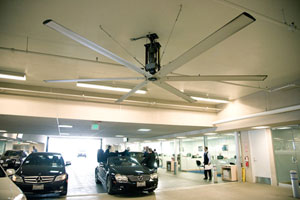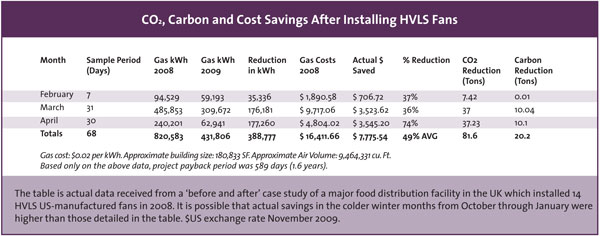HVAC for Large Spaces: The Sustainable Benefits of HVLS (High Volume/Low Speed) Fans
 |
Six-blade 14-ft HVLS fan cooling the service center at Mercedes Benz of Beverly Hills, Beverly Hills, CA. Image courtesy of MacroAir Technologies |
Distribution and warehousing
In these large, ever-changing environments requiring open doors, obstructive machinery, and almost constant movement, heating, cooling, and proper ventilation are often challenging undertakings. HVLS fans can help by providing ventilation in areas that are far from side walls or hemmed in by equipment. They can circulate air from air conditioning or heating systems to hard-to-reach or reconfigurable spaces without requiring extensive ducting systems. In addition, they can be positioned to provide ventilation for people working inside trailers and containers without creating an uncomfortable windy sensation.
Cold rooms
Cold rooms present their own unique challenges. Temperatures stratify in these rooms just as in other areas, forcing cooling units to do extra work. HVLS fans destratify the air, allowing the cooling units to do less work. They also help circulate the air over and through product racks, improving the effectiveness of the cooling units. Solar-powered HVLS fans can continue to operate during power outages or intentional shutdowns, reducing the chance of the product warming to unsatisfactory levels.

Commercial facilities
From big box retailers and shopping malls to auto dealerships, auditoriums, and sports complexes, customers must be kept comfortable. This is usually achieved by installing substantial air-conditioning and heating systems, often supplemented with small high-speed fans. HVLS fans can reduce the tonnage requirements for HVAC systems in these spaces because they do what they were designed to do: circulate air effectively and efficiently and provide a cooling effect in the process.
Agricultural applications such as horse and dairy barns
High temperatures have an adverse affect on both workers and animals. In high stakes horse barns and other animal environments deficient cooling and ventilation can negatively impact performance. In commercial dairy barns, for example, repeated studies have found that HVLS barn fans lower temperatures by 6-8 degrees F, resulting in significant increases in milk production. In addition, lower temperatures reduce spoilage and encourage flying insects to stay away or keep on the ground. Birds also react to large slow moving fan blades and stay outside. In cooler months, HVLS fans redistribute warmer air generated by animals, increasing comfort for both animals and workers without requiring a significant investment in expensive heating equipment.
One-of-a-kind spaces
HVLS fans have been used in a wide variety of unique spaces, from churches to fitness centers. Most manufacturers are happy to work with architects and engineers to develop custom solutions for all sorts of situations. HVLS fans allow designers to think outside the box because they can be adapted to many different environments.









